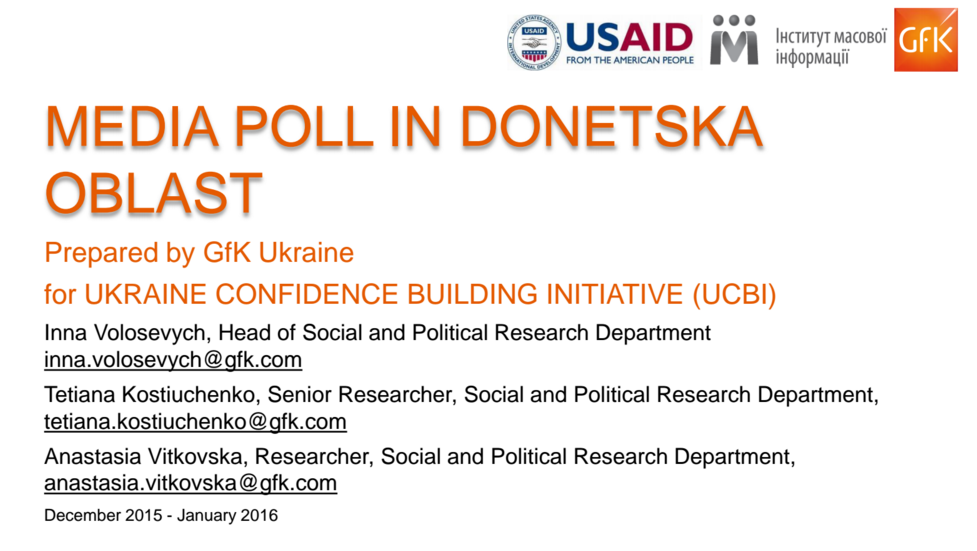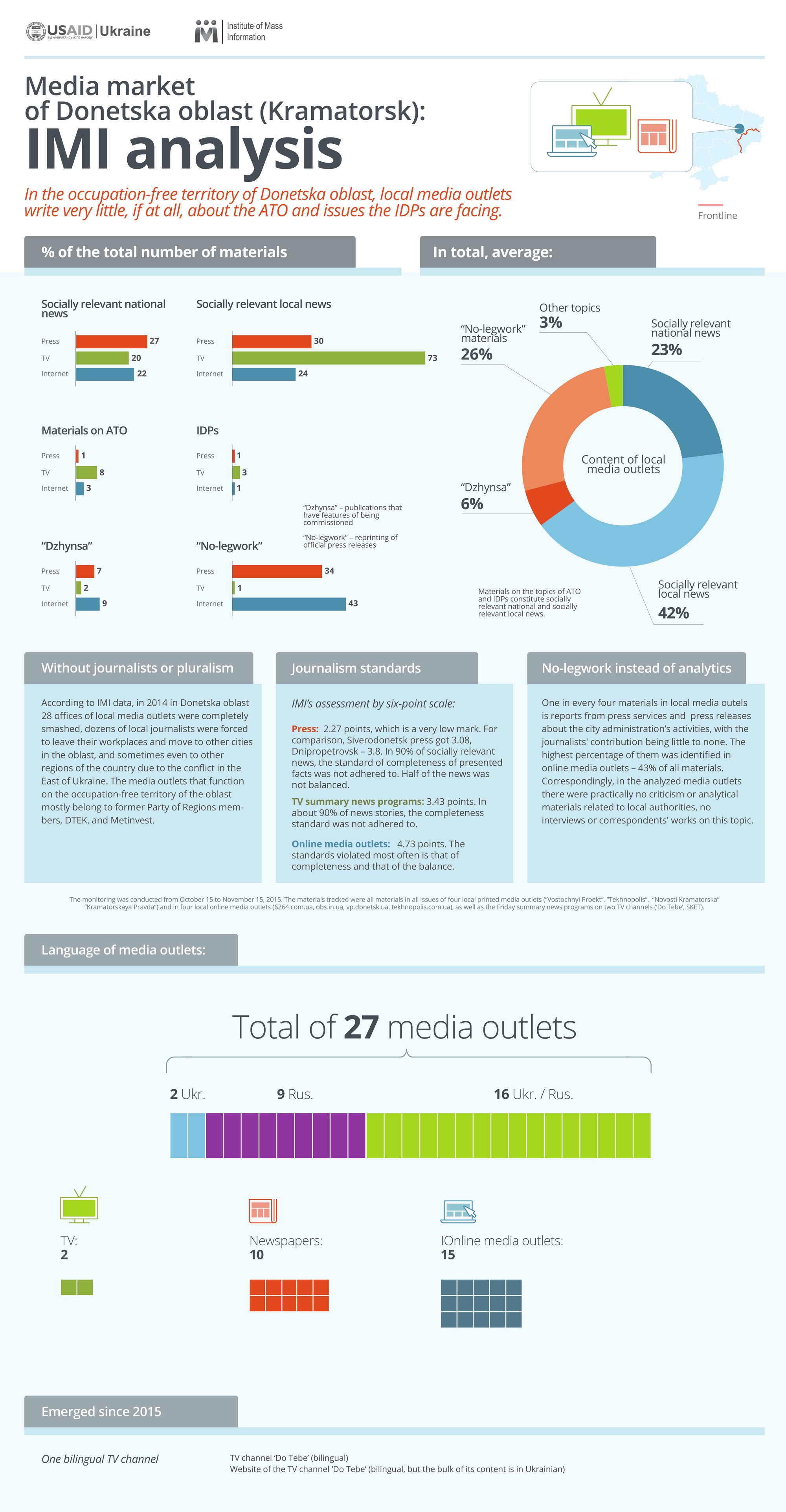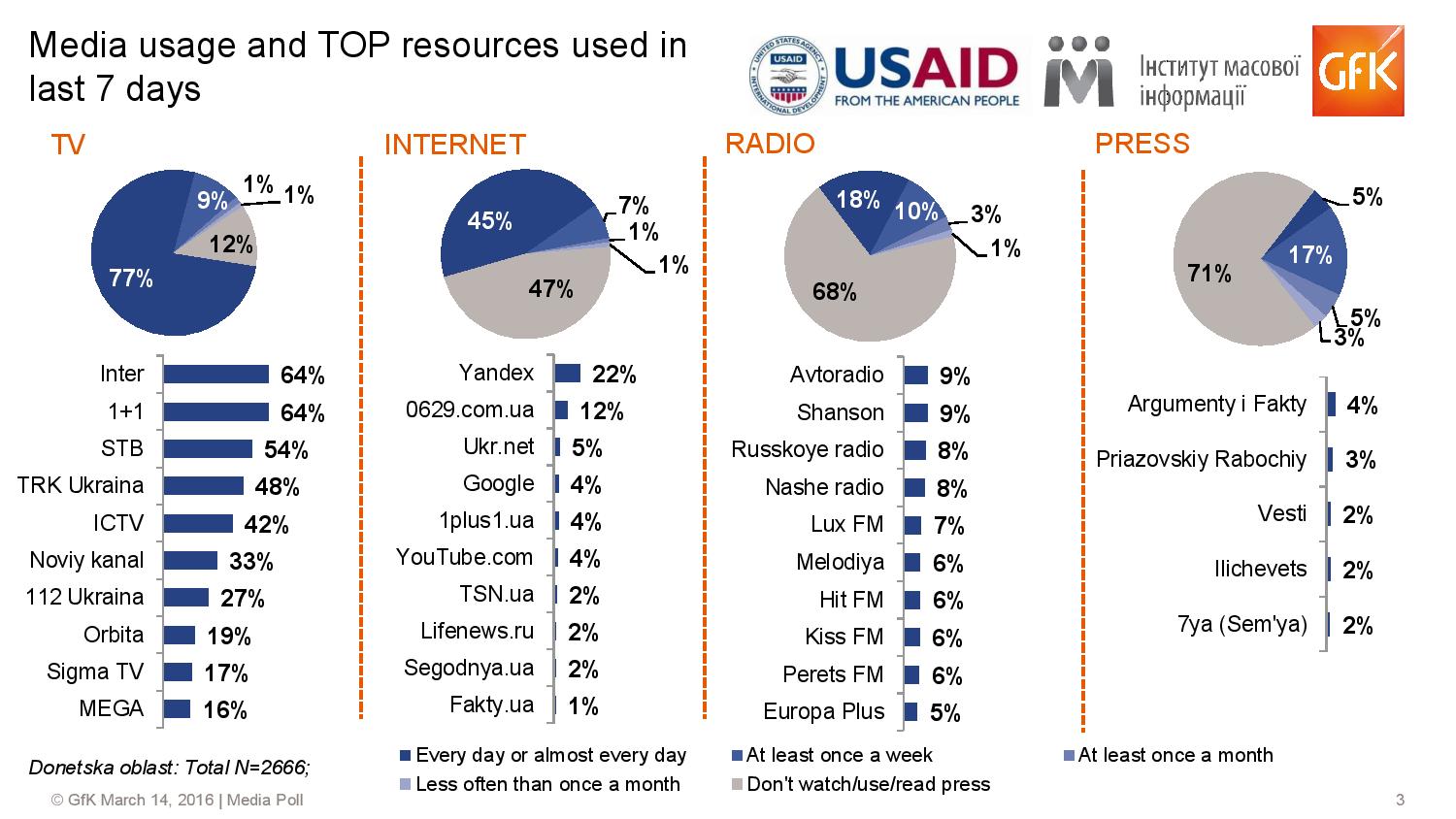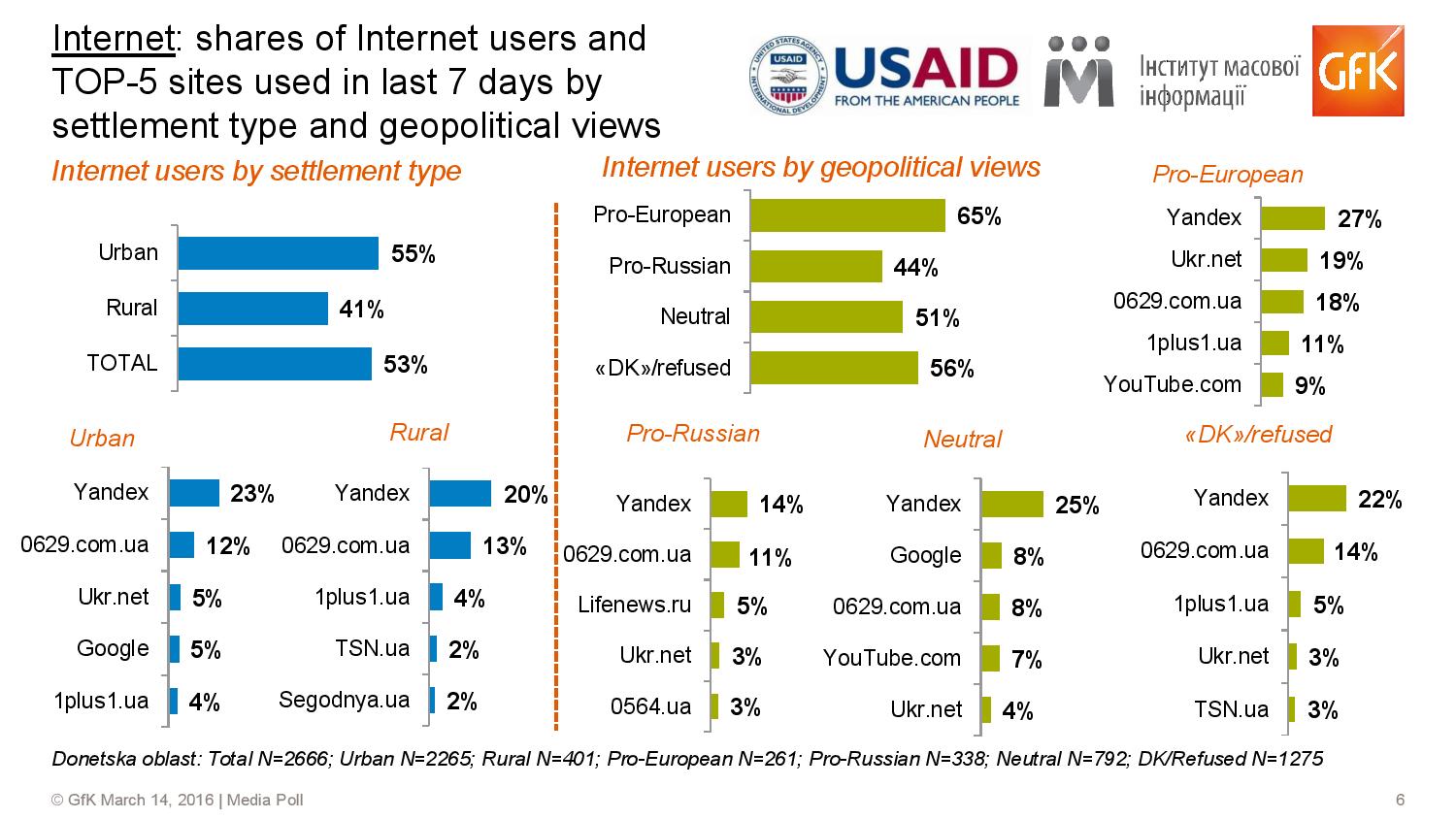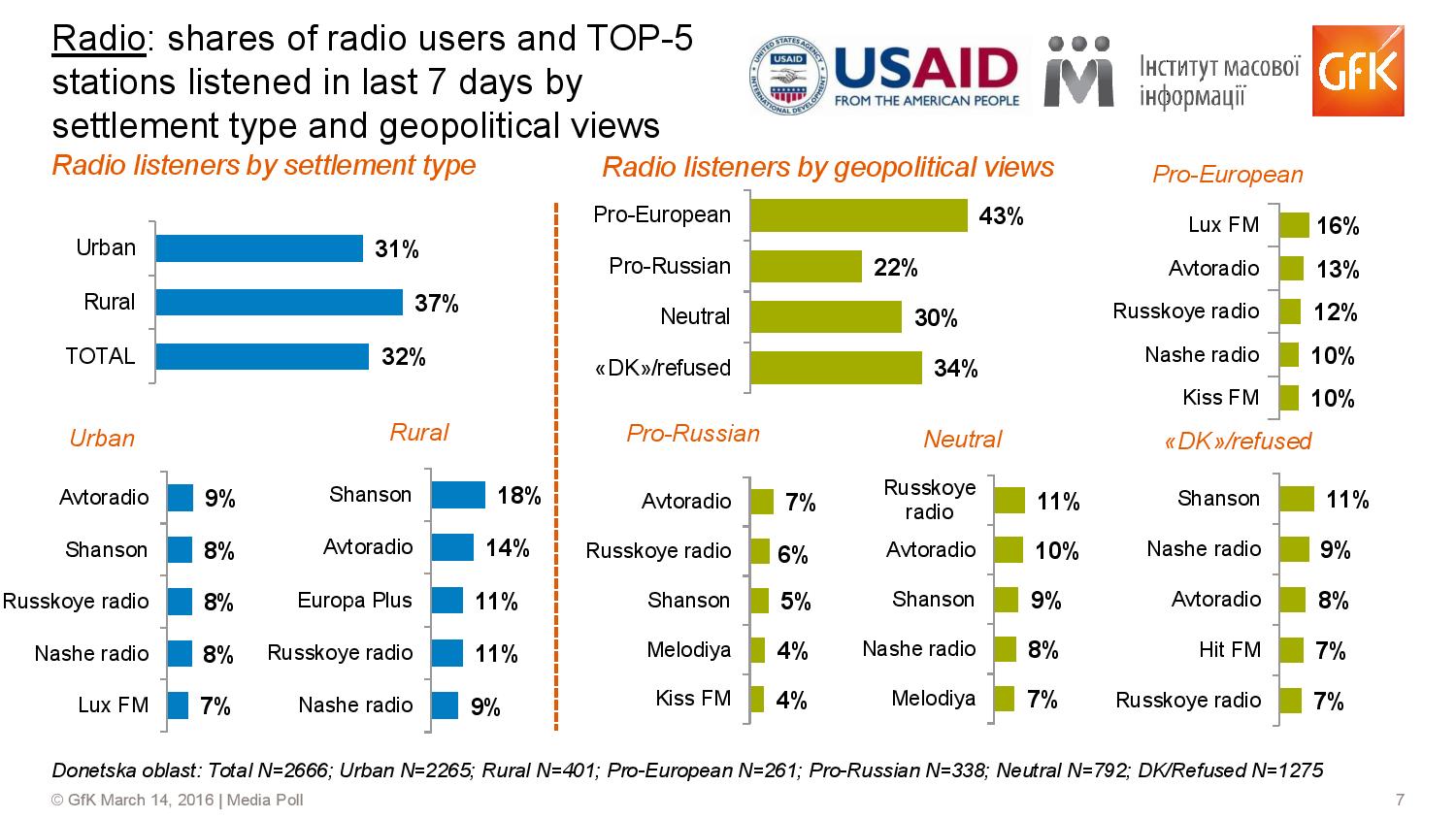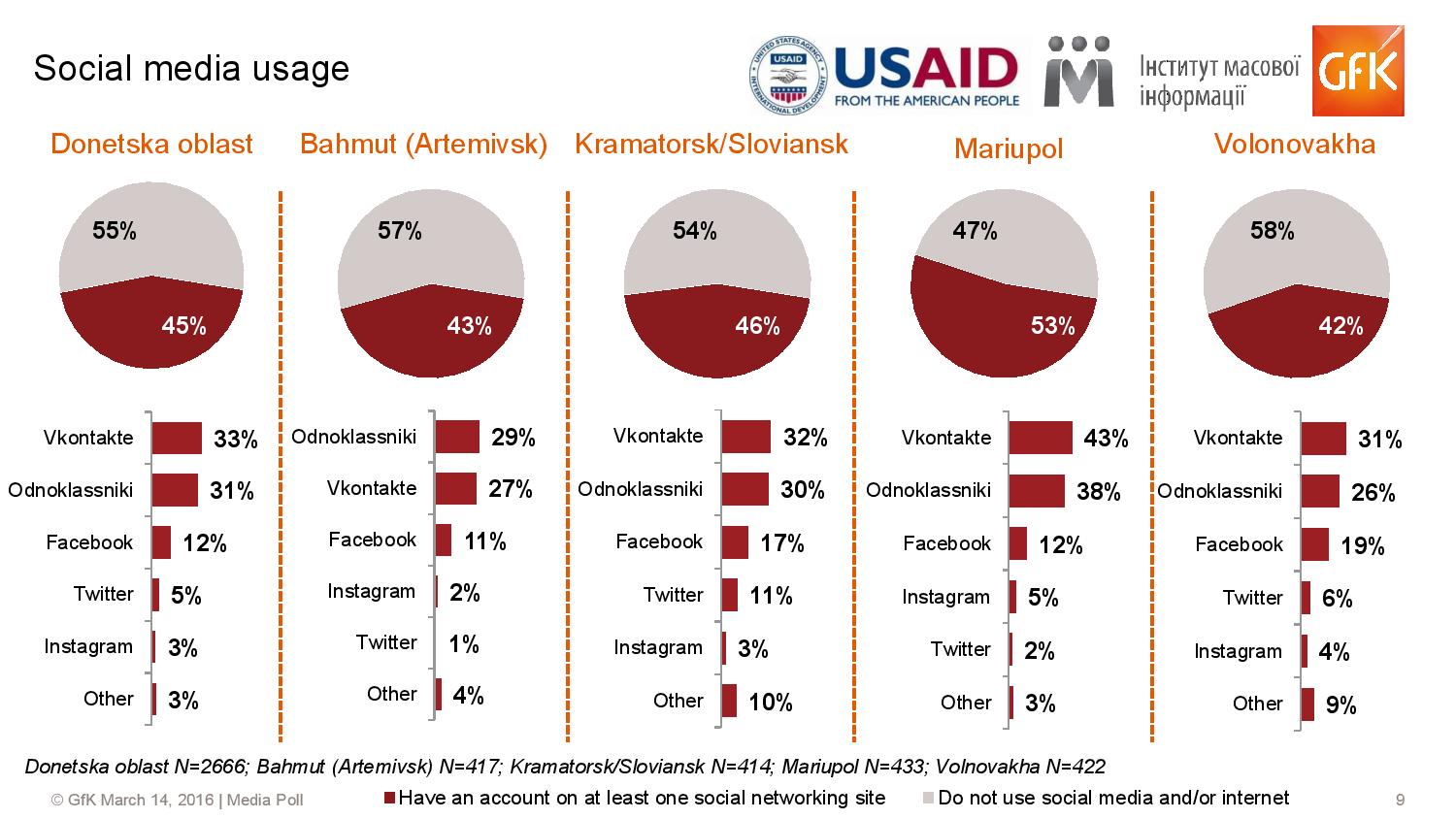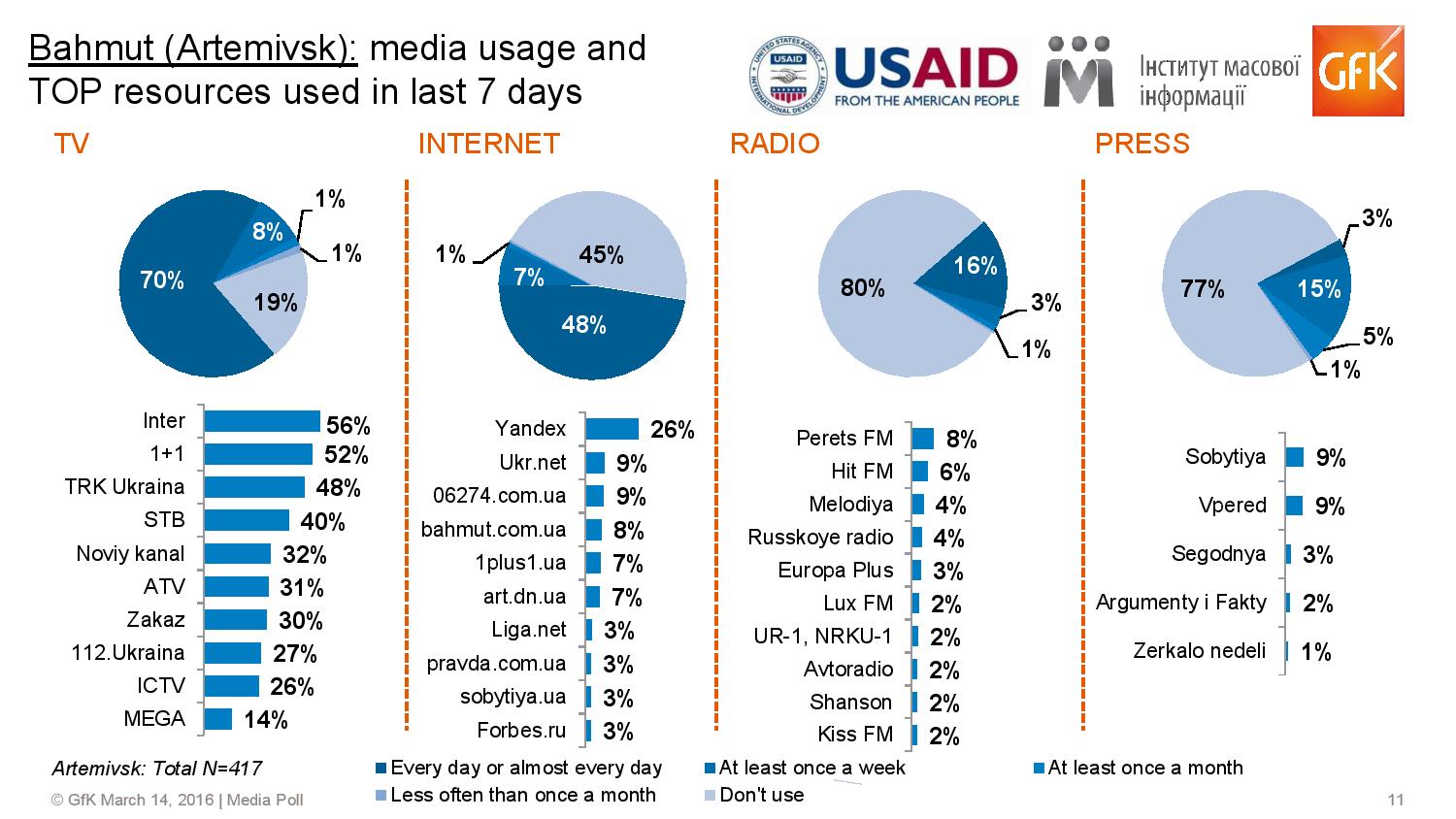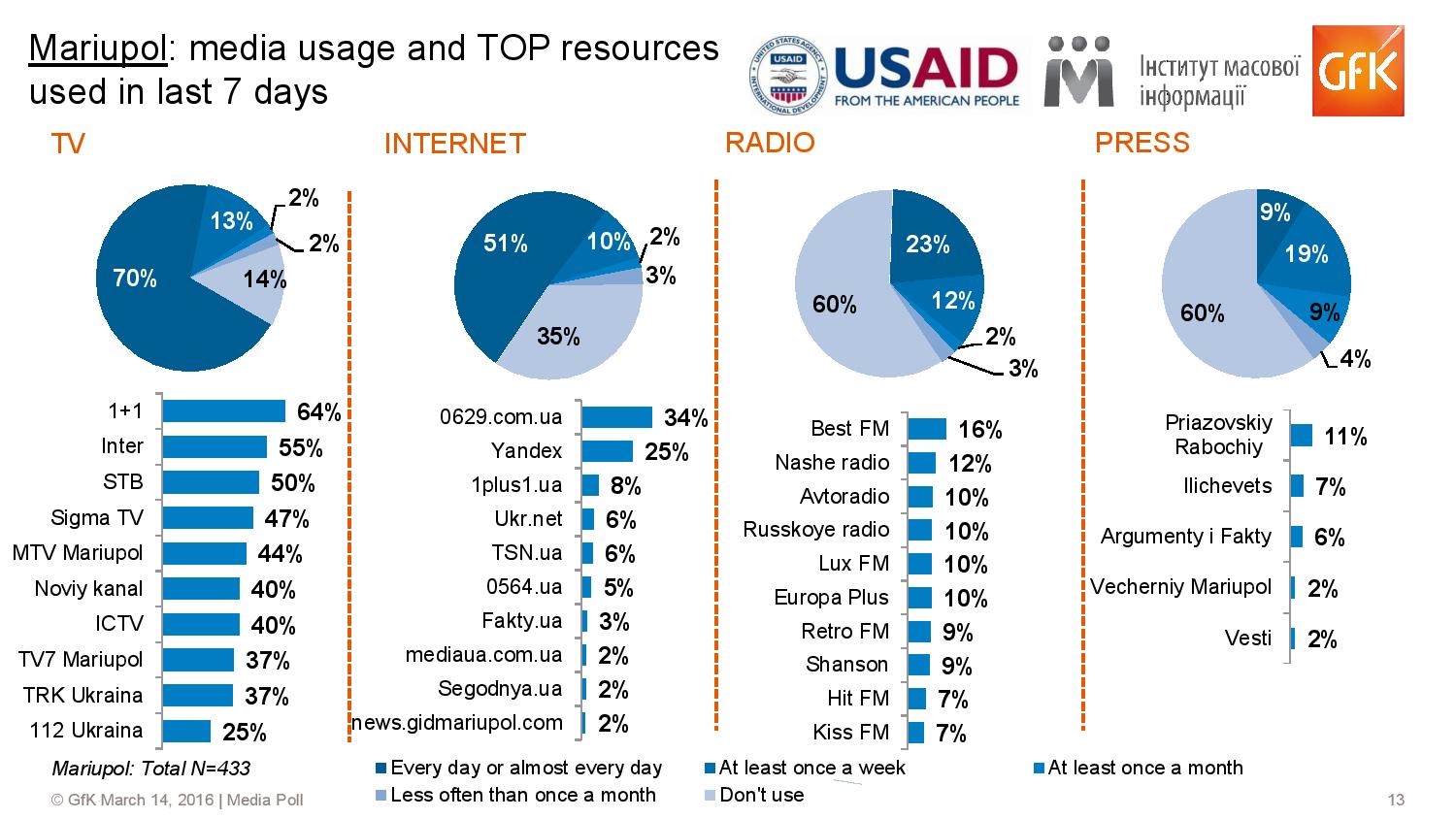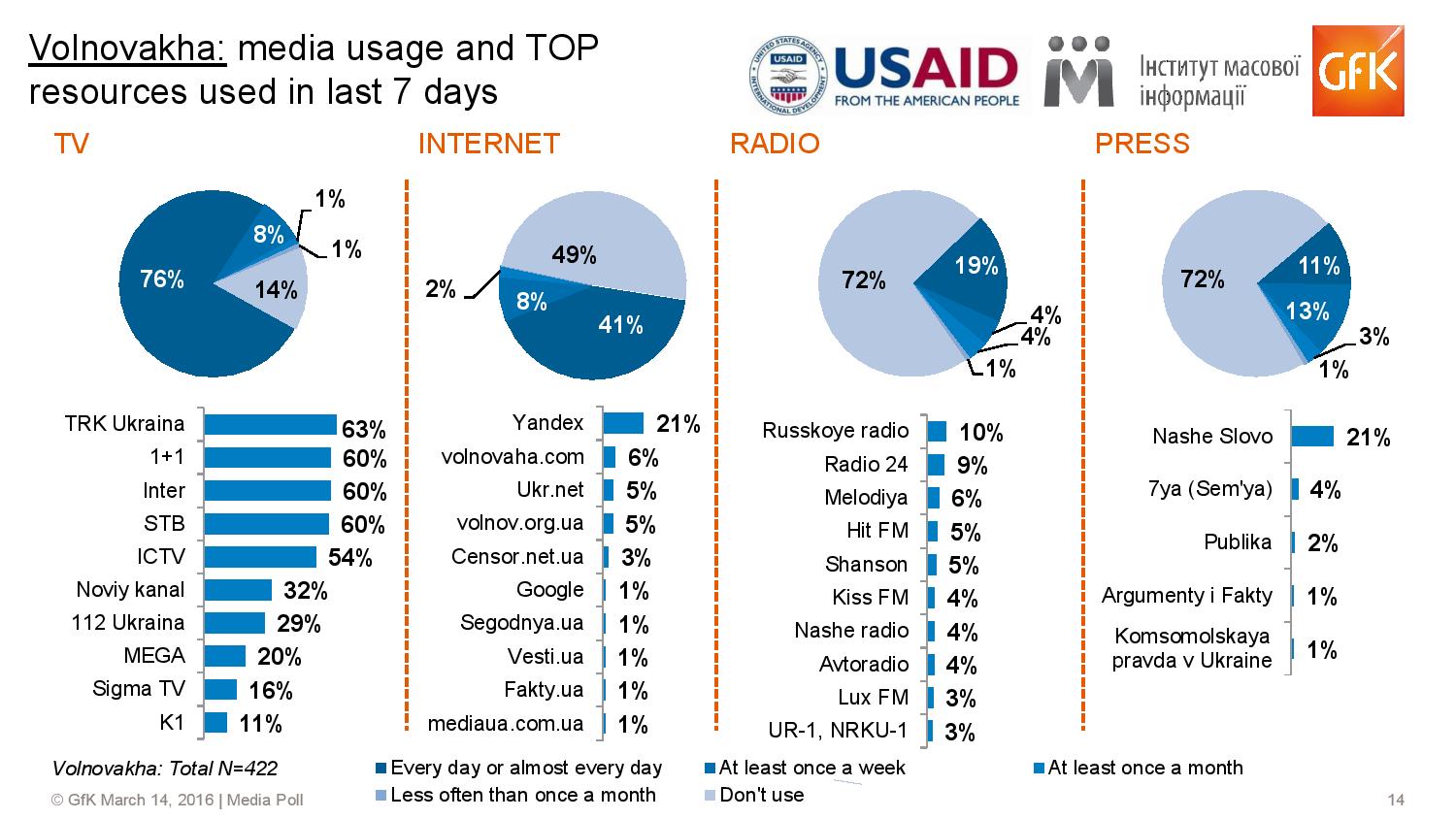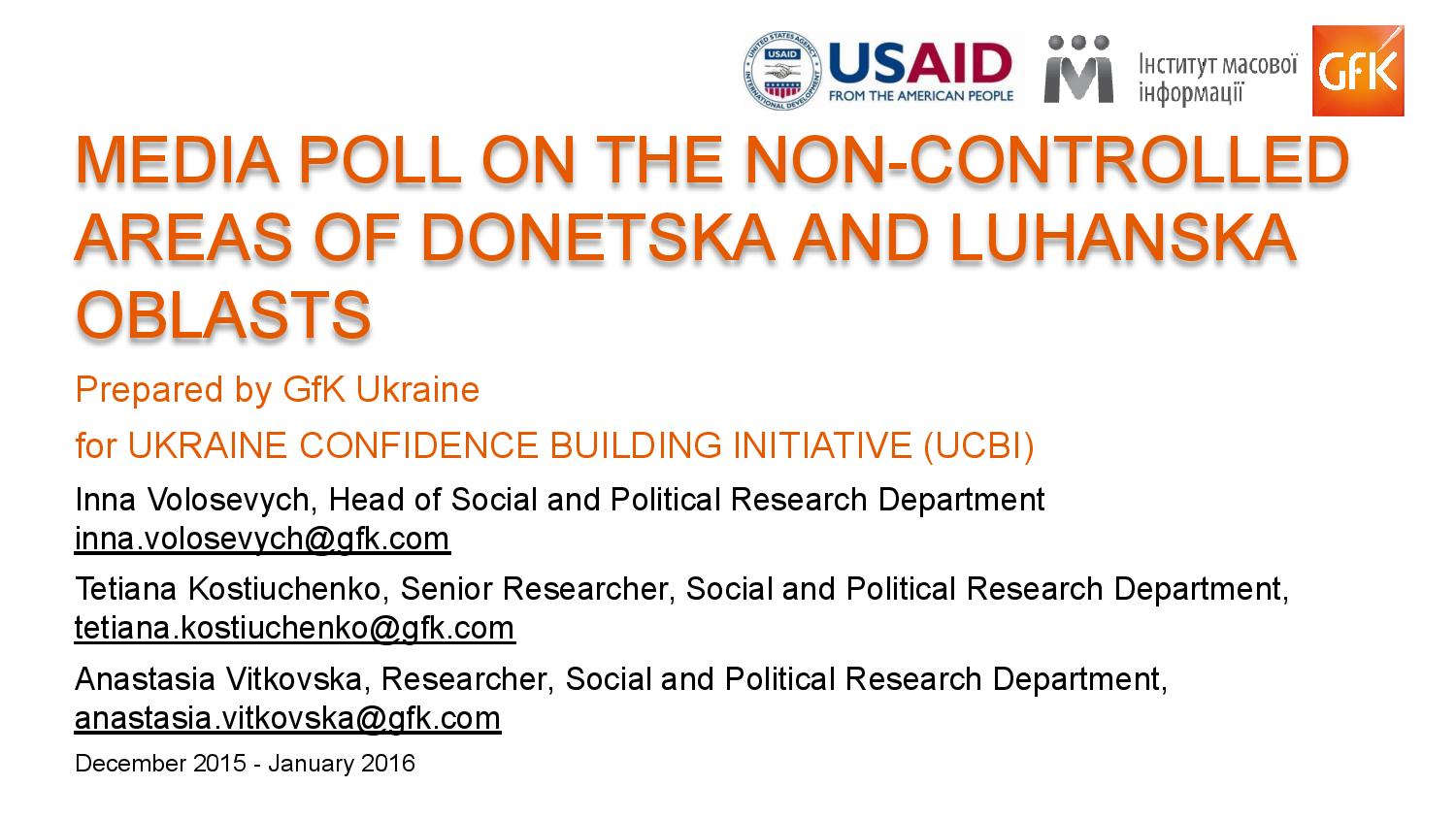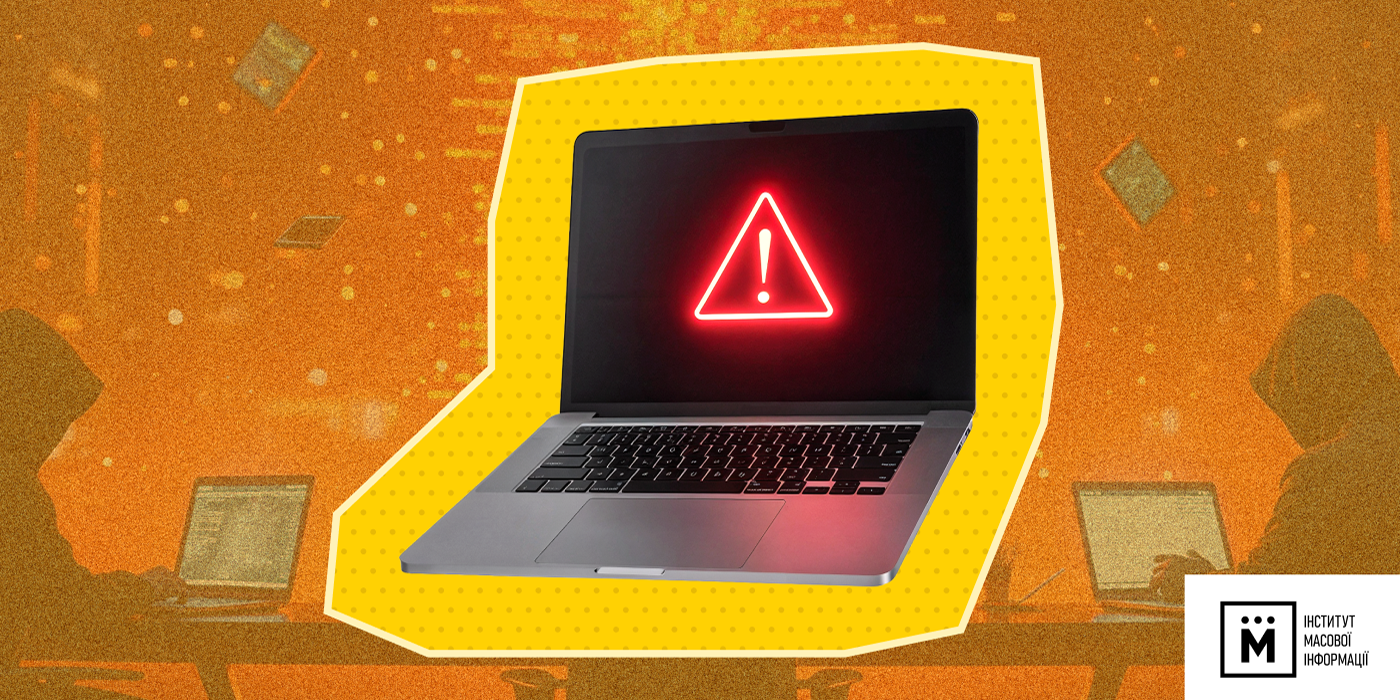Analysis by Institute of Mass Information
MAIN TENDENCIES OF MEDIA SPACE
According to IMI data, in 2014 in Donetska oblast 28 offices of local media outlets were completely smashed, dozens of local journalists were forced to leave their workplaces and move to other cities in the oblast, and sometimes even to other regions of the country due to the conflict in the East of Ukraine. The media outlets that function on the non-occupied territory of the oblast mostly belong to former Party of Regions members, DTEK, and Metinvest.
In the early 2000-s, a rather closed mass media system was formed in Donetska oblast, a system under supervision of the structures of Yanukovich, who was the governor of Donetska oblast at the time. Before, the media policy was controlled by the headquarters of this party, now local mass media outlets are guided by the owners, former Party of Regions members. As of the beginning of 2016, the largest local media owner is Metinvest. This is also the difference between Donetska oblast and other regions of the country, where the competition between different owners still existed – unlike them, in Donetska oblast the overwhelming majority of media outlets follows «the party line», although they publicly position themselves as «independent mass media». One more difference of Donetska oblast from other regions of the country is a large number of mass media in rayon centers and towns. For example, practically every city of the oblast has 2-3 local TV channels that function with support of former Party of Regions members; in rayon centers, there are 8-10 printed weekly editions in each. Such high saturation with mass media can be explained by the region’s high level of industrialization.
The great majority of local mass media, as they are owned by former Party of Regions members, follow the single course of the informational policy, which includes a mixture of pseudo-peaceful rhetoric, ignoring the war as such, and failure to notice the Russian aggression, and also indulgence towards pro-Russian rhetoric. The content of local TV stations consists of the news of their own production, plus Russian movies and programs. Because of this, local population perceives information of national mass media through the lens of Russian media information.
In Donetska oblast, the network of local radio stations is poorly developed; the ones available are predominantly nation-wide Ukrainian chain musical stations.
The region has such a particular phenomenon as factory newspapers with large numbers of copies, which quite substantially affect the media field, as the majority of city residents are to some extent employed at large factories and plants. An example of such newspapers is the free factory newspaper of Kramatorsk-based plant Novokramatorsky Machine Engineering Plant (NKMZ), which on every issue’s front pages publishes news about the plant’s cooperation with Russian factories, and uses openly pro-Russian rhetoric. As a result, this also is a factor of pro-Russian attitudes of Kramatorsk residents.
For now, the informational sphere of Donetska oblast consists of:
- national channels: TV and Radio Company «Ukraina» and Channel 112 – these channels are considered to be «on the same side» with locals; they speak using messages understandable and common for the residents of the oblast, the same messages that local mass media keep repeating;
- local TV channels that belong to former Party of Regions members, for example, in Mariupol this is Mariupol Television (MTV) and Sigma-TV. These two channels also belong to Metinvest, yet they position themselves as «city channels.» The Oblast State Television DonTV does not even print their program schedule in the newspapers. Also, one should remember that each rayon center has several small TV channels.
- most visited websites: 62.ua, 0629.com.ua – Mariupol (these websites are a franchise, they belong to a private individual not connected with politics), OstroV, «Novosti Donbassa», «Novosti Kramatorska», Hromadske TV of Donbas, mariupolnews.com.ua (website that belongs to the Mariupol city council member Petro Ivanov, who now resides in Crimea, the website is partly financed by Metinvest), and others. In each rayon center, there are two or three such websites.
- Printed press, weekly editions and communal press. For example, in Kramatorsk the newspapers that we came across were: communal newspaper «Kramatorska pravda» (founded by Kramatorsk city council, number of copies not indicated), «Vostochnyi Proekt» (founder LLC «Railroad casting», number of copies 10,000), «Publika» (founder V.Kononov, number of copies 67,378), «Novosti Kramatorska» (published by the private enterprise «Salari», number of copies 5,800), «Tekhnopolis» (LLC «KatLayf», number of copies 20,000) and newspaper for Kramatorsk and other areas «Ya» (founder S.A.Zubko, editor's office and printing facilities are located in Donetsk, number of copies 150,000). In Mariupol, the newspapers with the largest number of copies are «Priazovskiy rabochiy» (Metinvest, Mariupol), «Iliychevets. Gorod» (corporate edition of Metinvest), in Kostiantynivka – «Znamya Industrii» (owned by Borys Kolesnikov).
- Factory newspapers with large numbers of copies, up to 15 thousand copies.
- Communities in social networks.
Informational space of occupied territories
Due to the conflict in the East of Ukraine, dozens of mass media outlets in Donetska oblast were forced to cease operation. Those media outlets that continue to function on the territories controlled by the so-called «DPR», are broadcasting openly anti-Ukrainian propaganda. On the occupied territories, four TV channels function (Oplot TV, which functions on the basis of the captured local channel First Municipal; Novorossiya TV owned by Gubarev that works on the captured frequency of UNION and «1+1»; the «First Republican» channel that broadcasts on the frequencies of Channel 27, captured by the separatists, and the «Second Republican» channel, former UNION); Russian channels also broadcast here. All Ukrainian channels in the occupied territories were disconnected in summer of 2014. Local cable providers (based on different data, there are about 200 of them) also disconnected all Ukrainian channels from the network, but for some entertainment channels.
As to restoration of broadcasting of Ukrainian channels in the occupied territories, according to the Ministry of Informational Policy data, the occupied territories have access to the following TV channels: «1+1», «EspresoTV», Channel 5 and Suspilne Television of Ukraine – First National Channel, and also Hromadske Radio, and «Radio-24». Yet, the broadcasting coverage is not uniform: not all territories can receive the same signal – some places have access to just radio, some only to a single TV channel. According to the representatives of the Ministry of Informational Policy, even the existing towers are hard to restore – they are constantly under fire; for this reason, they restore transmitters that are farther away, and this makes their operation more complicated. At the same time, according to local residents, they have no access to Ukrainian channels, as the TV broadcasting tower located in Donetsk controlled by separatists, has a stronger signal.
On the occupied territory, several printed «DPR voices» are issued – the official newspaper «Golos Narodu» («People's Voice»), and the newspaper «Novorossiya.» Several websites are functioning – «Novosti Donetskoi Respubliki» («Donetsk Republic News»), «Donetsk News Agency», and others, which publish overt disinformation and propaganda like «Kyiv deployed Latvian mercenaries to frontlines», and report only positively about anything happening in the self-proclaimed republic. The number of users in social networks associated with both websites is about 10-15 thousand, the number of hits at the websites themselves – up to 40 thousand, according to the website counter.
Communities in social networks as source of information
In this situation, the main source of alternative news about the events in the region and in Ukraine for residents of the occupied territories are the Internet and word of mouth. On the Internet, there are the news websites OstroV, Novosti Donbassa («Donbas News»), Hromadske Television of Donbas, and communities in social networks. For example, the community in Vkontakte «Typical Donetsk» has 408 thousand participants, making it the largest local network community in all regions monitored by IMI. The group’s content is not really about politics, yet to some extent it is pro-«regional», typical for mass media of the part of Donetska oblast that is not occupied. This group is connected with the website of local news «Eto Donetsk» («This is Donetsk»), which presents information about events on the occupied territory, yet is quite lenient to the pro-Russian position. One more pro-Russian community is «Donetsk LIVE», which has over 47 thousand participants. There are 3 or 4 more similar communities, but they do not differ significantly from to the ones described above.
As to pro-Ukrainian communities, an example of these can be «This is Donetsk, baby! Typical Ukrainian city», which has only 35.5 thousand participants, and presents anti-Russian content.
The reasons of network communities being popular is, first of all, loss of trust in both pro-Russian and Ukrainian mass media that «decorate the reality». One more problem is the fact that Ukrainian mass media do not produce informational products for residents of the occupied territories, who require information on how to survive, how to stay safe, information about the needs of children, how to keep yourself warm, where to get food in the conditions where water or power supply in the city do not work, how to organize their daily routines. Instead, this information can be found in social networks and communities.
Situation in media space of Kramatorsk
After occupation of Donetsk, Kramatorsk became, in effect, an administrative center of Donetska oblast. The city is located in close proximity to the division line with the so-called DPR, this city survived occupation and shelling.
In the city with the number of residents, according to information of the Administration for Social Protection of Population, of about 200 thousand (plus about 45 thousand officially registered IDPs from the zone of hostilities), two TV companies – «SKET» and «Do Tebe», and one local radio station, «Meridian» operate; there is also the factory radio of «NKMZ». According to the city council’s information, «SKET» broadcasts its own programs only for two hours a day, and «Meridian» even less – one hour a day. At that, as IMI learned from the department of information of Kramatorsk city council, these mass media outlets were used, among other things, to cover the city council’s activities.
The region is quite heavily saturated with free pro-Ukrainian military leaflets, yet their main drawback is that they are not tailored for local population, they are anonymous, and often they are radical and are not taken seriously. They are handed out mostly in the areas, where the military are present, and are distributed through pro-Ukrainian volunteers. Due to this, they are not positively affecting the local population to any considerable extent, and for sure, they cannot compete with either the traditional mass media or the Internet.
In Kramatorsk, there are up to 15 news websites, whose traffic ranking averages 3-4 thousand hosts per day. As to the infrastructure and access to the Internet – unfortunately, for Kramatorsk no separate studies were conducted. There are approximate numbers for Donetska oblast, according to which over 40% of its residents had access to the Internet. Quite possibly, the same statistics is valid for Kramatorsk, too.
Up to 10 printed editions are published in Kramatorsk regularly – this includes both news, informational, and advertisement press, and this number does not include factory newspapers that are dispensed to factory employees. In Kramatorsk, at least three printed social and political printed editions belong to former Party of Regions member, now MP of the Presidential Faction (Petro Poroshenko Bloc) Maksym Yefimov, and publish his overtly commissioned materials. In Mariupol, the newspaper «Illichivets» tries to publish materials with criticism from time to time; yet «Priazovskiy Rabochiy» uses commissioned materials in its publications that are distributed by subscription, and tries not to publish such materials in the copies with the TV program (sold in retail) – possibly in fear of losing readers, most of whom buy newspapers just to get their TV program. Also, «Illichivets» does not publish «no-legwork» materials, and it gives an impression that someone ordered journalists not to mention local authorities – as if the mayor and municipal agencies do not exist in Mariupol. The same can be said about the local television – MTV. Here we should mention that neither «Illichivets» nor «Priazovskiy Rabochiy» are sold in retail kiosks, they sell only Saturday multiple page newspapers with TV programs. This part of the newspaper is what casual readers can buy; yet, the larger part of the copies is distributed to subscribers.
RESULTS OF QUANTITATIVE ANALYSIS OF DONETSK MEDIA
One of the key problems of Donetsk media market is practical absence of opinion variety, of criticism and analytics on local topics. Generally, the level of socially relevant materials in the monitored media outlets was 23% from the total number of materials; at that the highest level was registered in printed press (27%), and the lowest – on local television (20%). Local news make 42% of the socially relevant ones, the rest of them are about national-level agenda. Just like in other regions, more than one third of local news is often information about crimes or local political events; at that in the latter case presentation of the news is often biased.
The topic of ATO, in spite of the conflict being so close, is covered only in 4% of materials, and the journalists admit this fact, too. Very few of them cover events in the ATO zone; for example, in fact, none of them investigated the events near Mariupol, like why the residents can hear the bombardment, etc. And information about such events could be very important for residents of Kramatorsk, as it is vital for everyone’s physical safety.
From the total number of analyzed materials, at average 2% of materials are dedicated to the conflict-sensitive groups of population (IDPs).
During the monitoring period, in the content of mass media we were able to trace the attitudes of emphasizing the specific sufferings experienced by Donetska oblast; the motto «to hear Donbas» is one of the leading motives of local mass media.
One more peculiarity of local mass media is «no-legwork» news about the city administration’s activities, a kind of «surfing» without giving too much of interpretation. At average, «no-legwork» news comprised 26% from the total number of materials; at that, the highest percentage of them was identified on the Internet – 43%; in press, the same indicator was 34%, and the local TV was quite the opposite – only 1%. Thus, there were practically no criticism or analytical materials related to local authorities, no interviews or correspondents' works on this topic in the monitored media outlets.
The situation is somewhat better with commissioned materials and hidden advertisement – the average indicator for the three types of mass media (TV, press, and the Internet) was only 6%; at that, the highest level of hidden advertisement was registered on the Internet (9% from the total number of materials); in press, the same indicator was equal to 7%, and on TV – only 2%.
RESULTS OF QUALITATIVE ANALYSIS OF DONETSK MEDIA
Not only what kind of information is available for local residents from local mass media is important, but also of what quality this information is.
Media of Kramatorsk demonstrated a rather low level of adherence to standards of journalism – the average indicator for the three surveyed media outlets was only 3.6 points out of maximum 6.
Printed press had the worst indicators – 2.75 points. The content of newspapers is crime reports, social topics, and also materials marked «Political agitation», or straightforward unmarked advertisement («dzhynsa»); there are no any other news on political issues – neither local nor national – despite the fact that the monitoring was conducted in the pre-elections period.
The topics relevant for the society in the monitored period were related to EU grants and testing of candidates for positions of patrol police officers. At that, all four monitored media outlets were covering these topics in the same manner in the form of reports. There was an impression of the media outlets being quite detached from their audience, as there were no materials presenting the city residents’ point of view or vision. There are many «no-legwork» materials like «At the administration meeting on November 10, Director of Kramatorsk Trolley and Tram Department Andriy Vorokha reported the current status of the communal enterprise that he is assigned to administrate». No competition between media outlets can be seen.
In 90% of socially relevant news, the standard of completeness of presented facts was not adhered to. Half of the news was not balanced. In addition, the headlines are often not corresponding to the content of the news, or say something completely contrary to the content.
The highest professional standards adherence indicators were identified in online media outlets – 4.73 out of 6 points. Yet here, political news are practically completely ignored, too. In fact, all news about political issues looked like they were commissioned by local politicians.
The main topic covered in the area of local authorities' activities was regarding the issues of renaming the streets, also without giving the residents’ opinions. The number of news about crime is high, for example, «Kramatorsk law enforcers detained a group of drug dealers, from whom they confiscated…» – «Vostochnyi Proekt», «Crime map of Ukraine» – 6264, «Near Mariupol, offended grandson gave acid to his granny, and she died» – «Obshchezhytiye».
At the website «Tekhnopolis», a large sector of content is dedicated to the occupied territories, which IMI experts see as a positive factor. Yet, it should be mentioned that these news are mainly about negative things that happen on these territories. For example, «IN THE OCCUPIED PART OF DONBAS, OVER ONE HALF OF POST OFFICES CLOSED DOWN», «Students of "DPR" will not have scholarships», «In what conditions are heating networks workers in occupied Horlovka working?».
In online media outlets, the standards of completeness and balance were violated most often.
Kramatorsk TV received 3.43 points out of 6. The majority of news were about social issues, yet the opinions of the community members were never presented there. The topics of national Ukrainian level are practically not covered. The political topics are also almost non-existent. About 90% of news are presented in an incomplete manner.
It should be mentioned that Kramatorsk media outlets were unprepared for becoming mass media of oblast scale, as their quality and content is insufficient for this status.
ASSESSMENT OF SITUATION BY LOCAL JOURNALISTS
One of the factors the journalists themselves complained to IMI about was lack of professionalism of local mass media, caused, for example, by the owner's desire to save money by not hiring qualified journalists. According to the local IMI representative in Mariupol, at Mariupol television, most of the staff reporters in the information department are students, who either recently graduated from local higher educational institutions or are still studying there, and a similar situation can be observed in other mass media outlets of the region. In addition, few people visit specialized trainings – the problem with topic selection can be seen with the naked eye, almost no one does journalist investigations: journalists try to stay away from conflict situations that are too complicated to analyze. Journalists are also not ready to argue with their editors or resist the established editorial policy.
The preliminary survey of the local journalists shows that the journalists themselves do not trust the content of local mass media, and very often tend to double-check it and be very critical about it. The most trusted media outlet is the website 0629.uа. The reason of this trust is its prompt response to events and an independent owner that does not have any interests on the local level, compared to local mass media outlets’ total dependence from the Party of Regions members. According to the journalists, one of the main problems of the region is the fact that the owner of most local mass media outlets is LLC «Metinvest Holding», so all editorial policies are controlled and unified.
The journalists feel constant lack of information, they do not understand what the future of the city can be, which causes their readers not to understand what influence ATO events have on the life of the city and city residents.
Local journalists learn about local events, traditionally, from websites of local governmental agencies, from press releases, from personal contacts and local websites. We can observe a considerable narrow-down of the media focus. Local mass media are reporting practically nothing about social topics, stories of people, day-to-day life, culture, food, entertainment – instead, the focus shifted to the military topics. The paradox of such situation is that the local journalists do not visit the frontlines at all, so they cannot really describe the situation in the ATO zone first-hand. The journalists complain that the mass media in the region continue to get monopolized, and soon it will be difficult to find on the market two media outlets that belong to different owners. At the same time, the many media outlets owned by the monopolist create a false impression of diversity, but in reality they share the same point of view when covering events. Among the problems, the journalists mentioned small numbers of staff journalists, censorship by owners, low salaries and overwhelming quantity of commissioned materials («dzhynsa»). As a summary, according to the local journalists, one of the greatest problems of mass media in Donetska oblast is total lack of trust inside the media community, impossibility to verify information, and total dependence from the «single owner».
Analysis by GfK Ukraine
